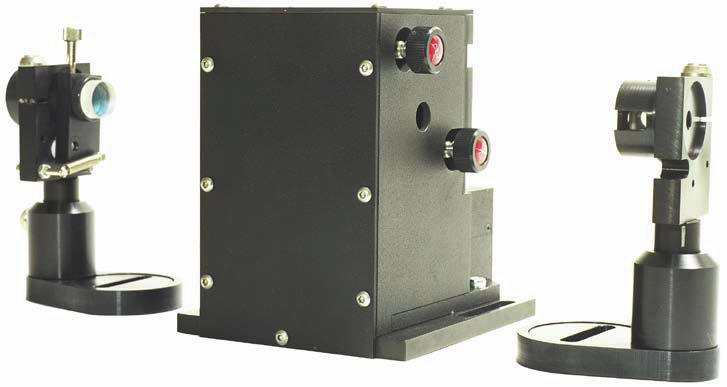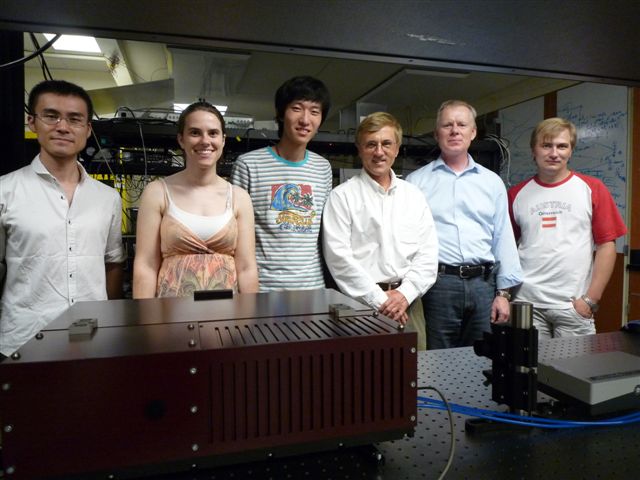Del Mar Photonics
 |
Pismo
pulse picker
The Pismo pulse picker systems is as a pulse gating system that lets single
pulses or group of subsequent pulses from a femtosecond or picosecond pulse
train pass through the system, and stops other radiation. The system is
perfectly suitable for most commercial femtosecond oscillators and
amplifiers.
The system can pick either single pulses, shoot bursts (patterns of single
pulses) or pick group of subsequent pulses (wider square-shaped HV pulse
modification). HV pulse duration (i.e. gate open time) is 10 ns in the default
Pismo 8/1 model, but can be customized from 3 to 1250 ns upon request or made
variable. The frequency of the picked pulses starts with single shot to 1 kHz
for the basic model, and goes up to 100 kHz for the most advanced one.
The Pockels cell is supplied with a control unit that is capable of synching
to the optical pulse train via a built-in photodetector unit, while electric
trigger signal is also accepted. Two additional delay channels are available
for synching of other equipment to the pulse picker operation. Moreover, USB
connectivity and LabView-compatible drivers save a great deal of your time
on storing and recalling presets, and setting up some automated experimental
setups. One control unit is capable of driving of up to 3 Pockels cells, and
this comes handy in complex setups or contrast-improving schemes. The system
can also be modified to supply two HV pulses to one Pockels cell unit,
making it a 2-channel pulse picker system. This may be essential for
injection/ejection purposes when building a regenerative or multipass
amplifier system.
|
Pismo pulse picker systems -
request a quote
Possible wavelength: 250 - 2100 nm
Adjustable amplitude up to 12 kV
HV pulse adjustable delay
HV pulse duration from 3 to 1250 ns
Fast rise time down to 1 ns or less
Single-shot up to 100 kHz picking rate
USB control and LabView drivers
Low jitter <200 ps
Built-in optical trigger
Two additional sync channels
When sending us your request for quotation please indicate
the following parameters:
Define the wavelength range that you need the system to operate in. The
wavelength defines the voltage that you need for your application. See the FAQ
section for further explanation on this subject or just send us the desired
wavelength and we will offer the right voltage and ARC.
Check if you need the default 10 ns HV pulse duration (gate open state). E.g. 10
ns duration suits femtosecond pulse train around 80 MHz or 1-5 kHz Ti:Sapphire
amplifier control. Other custom durations and variable modification are
available.
Let us know if you require a 2-channel system or a second Pockels cell.
 |
Trestles LH10-fs/CW laser system at UC Santa Cruz Center of
Nanoscale Optofluidics
Del
Mar Photonics offers new
Trestles fs/CW laser system which can be easily
switched from femtosecond mode to CW and back. Having both modes of operation in one system dramatically increase a
number of applications that the laser can be used for, and makes it an ideal
tool for scientific lab involved in multiple research projects.
Kaelyn Leake is a PhD student in Electrical Engineering. She graduated from
Sweet Briar College with a B.S. in Engineering Sciences and Physics. Her
research interests include development of nanoscale optofluidic devices and
their applications. Kaelyn is the recipient of a first-year QB3 Fellowship.
In this video Kaelyn talks about her experimental research in nanoscale
optofluidics to be done with Trestles LH laser.
Read more news in our
newsletter! |
The Pismo pulse picker systems is as a pulse gating system that lets single pulses
or group of subsequent pulses from a femtosecond or picosecond pulse train pass
through the system, and stops other radiation. The system is perfectly suitable
for most commercial Ti:Sapphire femtosecond oscillators and amplifiers as well as for
many other popular laser systems if you require quick and versatile control over
pulse repetition rate.
The system can pick either single pulses, shoot bursts (patterns of single
pulses) or pick group of subsequent pulses (wider square-shaped HV pulse
modification). HV pulse duration (i.e. gate open time) is 10 ns in the default
Pismo 8/1 model, but can be customized from 3 to 1250 ns upon request or made
variable. The frequency of the picked pulses starts with single shot to 1 kHz
for the basic model, and goes up to 100 kHz for the most advanced one.
The Pockels cell is supplied with a control unit that is capable of synching to
the optical pulse train via a built-in photodetector unit, while electric
trigger signal is also accepted. Two additional delay channels are available for
synching of other equipment to the pulse picker operation. Moreover, USB
connectivity and LabView-compatible drivers save a great deal of your time on
storing and recalling presets, and setting up some automated experimental
setups. One control unit is capable of driving of up to 3 Pockels cells, and
this comes handy in complex setups or contrast-improving schemes. The system can
also be modified to supply two HV pulses to one Pockels cell unit, making it a
2-channel pulse picker system. This may be essential for injection/ejection
purposes when building a solid-state Ti:Sapphire or Cr:Forsterite regenerative or multipass
amplifier system.
The system comes with everything you need to set up a half-wave voltage scheme
of pulse picking and synching it to your laser source. Please refer to our FAQ
section for more details.
|
Possible wavelengths |
250-2100 nm |
|
Output voltage |
up to 12 kV |
|
Output frequency |
single-shot...100 kHz |
|
Rise time |
from 700 ps |
|
Gate open time (HV pulse duration) |
up to 1250 ns |
|
Jitter |
< 200 ps |
|
Input sync signal |
optical or electric |
|
Input optical pulse train repetition rate |
up to 150 MHz |
|
Adjustable delay |
up to 800
µs |
-Cxxxx –
custom fixed HV pulse duration (gate open time) where xxxx is chosen from 10 to
1250 ns.
-V – variable HV pulse duration (gate open time) from 10 to 1000 ns. HV pulse is
flat-top square-shaped.
-F- fast rise time modification. Rise times down to 700 ps upon request.
-2 – 2-channel system for driving one Pockels cell with two HV pulses. Perfect
for injection/ejection in solid-state fs amplifiers.
What is the connection between the amplitude of the HV pulse
and the operational wavelength of the pulse picker system?
The high-voltage driver supplies high voltage to the crystal in the Pockels cell
and the crystal becomes transparent to a certain wavelength depending on the
amplitude supplied and the scheme of the setup (known as half-wave or
quarter-wave voltage schemes). Thus in a half-wave scheme the voltage amplitude
in kV roughly corresponds to wavelength in hundreds of nm, i.e. if you require
the system for 800 nm you are looking for ~8 kV unit, 1064 nm – 10 kV etc. The
quarter-wave scheme reduces the necessary voltage by half opening up
possibilities of wavelengths up to 2100 nm with only ~5-6 kV, but in this case
the overall transmission of the system will also be reduced, as the beam will
have to pass 4 times through the system vs. 2 times in the half-wave scheme.
Pismo
10/1-8/1-RTP complete pulse picker system with two Pockels cells
Pulse picker Pismo for Coherent Mira900F 80MHz femtosecond laser
Pismo pulse picker for 1500-1600nm range
Pismo Pulse Pickers: Electro-Optical
Ultrafast Shutters - pdf brochure -
typ.specs -
Pismo pulse picker
for laser wavelength: 1025~1045 nm
Femtosecond Pulse Pickers Pismo Questions and
Answers - 100kHz -
Pismo OG10B/100-1/DKDP 100kHz quote -
Pismo OG10B/100-1/BBO -
Pismo 8-1 Manual -
Pismo 8-10 -
Pismo 8-25 Manual -
QA1
- QA2
- QA3 -
QA4 -
QA5 -
Pockels Cell -
selection of pulses from a ~
100 MHz, 20 fs Ti:Sapphire laser -
pulse selection for polarization
flip - Pulse
peaker for Chameleon Ultra I from Coherent
Pulse picker for Tsunami laser
Pulse
Picker Pismo for Ti:Sapphire laser MIRA Optima 900-D (Femto,Pico) 76 MHz, 800 nm
from Coherent -
Pulse picker for polarization control
Pockels cell based on Rubidium
Titanyle Phosphate – RbTiOPO4 crystal
Ultrafast Shutter
